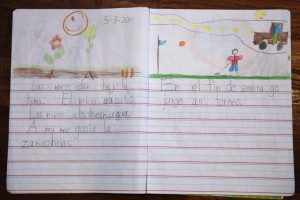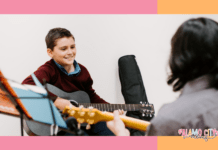Why Do We Believe In Dual Language Education?
The number one question we get when people find out our children are learning in Spanish 90% of the day? “Do you guys speak Spanish?” “No, my husband and I don’t speak fluent Spanish.” The extent of my Spanish is the several years of classes in middle and high school and one summer abroad in Spain. I know about as much as a 1st graders vocabulary and can ask, “Where is the bathroom?”
I have a kindergartener and first grader that are both part of the NEISD Dual Language Program. Since starting on the first day of kinder, they have been immersed in Spanish 90% of the day. For me, it was a no brainer to place them in this program, especially when I considered the difficult time I had attempting to learn a second language at twelve years old, the competitive advantage speaking a second language has in the business world and the fact that study after study shows that the brain of a person who speaks multiple languages is more evolved. Before embarking on this path, we did a lot of research looking at longer term testing results and we repetitively found results like this one:
“Native English speakers also benefit academically. In Houston in 2000, native English speakers who had been in the two-way dual-language programs for four years scored between the 63rd and 70th percentile in total reading scores on the Stanford 9, whereas the scores of native English speakers in the mainstream hovered around the 50th percentile. When tested in Spanish using the Aprenda 2, the dual-language native English speakers scored between the 65th and 87th percentile at the end of grades 2–5, with an average score equivalent to the 76th percentile. These native English speakers, including African-American students, not only scored higher than their monolingual educated peers, but they also acquired a second language for their lifelong use.” The Multiple Benefits of Dual Language
Boerne ISD also has a wonderful document of cited sources containing studies about “What the Research Says.” of Dual Language learning.

How It Works? (in NEISD)
My children are at a new NEISD elementary school, where as of 2013, there are MORE Spanish Dual Language classes for kindergarten than English-speaking ones. The goal of the program is to have 50%/50% Spanish to English speakers so that the English speakers can rely on the true Spanish speakers to help learn the language quickly. Each year, the curriculum increases the English percentage by 10% until it is at 50%/50% by fourth and fifth grade and as a natural result, the Spanish speakers start learning more and more from the English speakers.
As far as my experience of getting my children enrolled, I can only speak to the most recent two years of the NEISD process but I do know that the demand at certain campuses has EXPLODED. There was a wait list this past year of over thirty children after filling four classes.
Nearly every district in the San Antonio area has some kind of Spanish program. For instance, AHISD has two separate programs that like Comal ISD, begin in first grade rather than kinder. If you are at all interested in this type of program, I would recommend you begin to research the process a year before your child starts kindergarten so you don’t miss any important meetings or deadlines. Here are a few links to resources I found for you to start your research:
AHISD (Spanish Immersion and Dual Language)

Frequently Asked Questions
Do you or your husband speak Spanish? No, however, I did take a few years of it in middle and high school and I know only basic vocabulary.
How can you help them with homework? In our experience, the assignments come home in both English and Spanish. In kindergarten, the homework is pretty simple and even my husband, who has no Spanish knowledge, can easily help complete it. As a first grader, Carter can read everything in Spanish and complete everything on his own. We help both of our children with certain words by having a simple app available like Google Translate.
How do you read to/with them? That was probably the most common question posed to the kindergarten teachers. Since the alphabet sounds are slightly different, once they start reading on their own, it is important that they start to only think sounds in Spanish or they will get incredibly confused. It was strongly recommended that from the first day of the program and on, we do not try to teach them to read in English or it will only delay their learning to read in BOTH languages. I have heard by 2nd grade, they can start differentiating the alphabet sounds more easily and will be able to read in English without getting as confused. When we read at night to our kindergartener, I read English only as not to confuse them with my horrific Spanish pronunciation. Later in kinder and in first grade, they come home with books at their level to read to me in Spanish.
When did you start the process of getting them in the program? This varies per school district and program. Three years ago, the process to get a child into the NEISD program was 100% different from today. My biggest advice is to start actively looking into it earlier rather than later. If you are serious about it, begin researching the programs in your area and asking people about it almost a year before your child actually enters kindergarten. Some districts have mandatory meetings that could start as early as December, a full nine months before your child is set to enter kindergarten.
What is difference of Spanish Immersion and Dual Language? A Spanish Immersion Program is designed for a classroom filled with native English speakers to be immersed in Spanish, so all children are learning a second language at the same time. A Dual Language Program is where the class is split (ideally evenly) between both English and Spanish speakers to allow for an added way of learning from their peers. Both programs concentrate on instruction in Spanish during the primary years, slowly adding in more instruction in English each year.
My BIGGEST ADVICE to other new parents that was shared with me over two years ago:
1) You must have faith in the program during the first year. There will be weeks and months where you ask your son/daughter what they learned today and they will shrug their shoulders and say they don’t know. It’s OKAY!!! It’s kindergarten! Their little sponge of a brain is taking it all in and I promise is will explode once it “clicks,” which can vary from the Winter Break time or half way through the Spring semester. Although my son showed slow progress throughout the year, the second week of first grade (a whole year after starting the program) is when we saw a night and day difference in his Spanish speaking skills. We knew he understood the majority of everything spoken to him in kindergarten, however, his actual speaking of this new language was limited to 2-3 word Spanish responses.
2) If you are not a Spanish-speaking family at home, find a way to get into/volunteer in the classroom after a few months. My husband volunteered for the dad’s WATCH DOG program in December of Carter’s Kindergarten year and that is where we realized how much Carter was learning and could actually speak the language!!!! Seeing him in that environment, answering his teacher’s questions and hearing him talk in Spanish, was the single biggest confirmation that we had made the best decision for our son! The take-a-way being, if you are a non-Spanish speaking family, it is hard to tell how much they know!
3) The amount of progress your child show depends on their own personality. Our older son is extremely bright but showed us way less of his Spanish learnings than his one-year-younger sister has, during the same time period. She is much more out going and makes a big point to show off her learnings of the day!
4) If you are on the fence about the program, I would recommend making a decision to commit or not and don’t look back! Remember that five and six-year olds are resilient, amazing human beings that don’t know that learning a second language isn’t the norm. Don’t confuse your feelings of being afraid of the unknown with your child’s naiveness to change. We didn’t make a huge deal to Carter and Addie about the Spanish program. We told them that they may not know what the teacher is saying the first few weeks but that is OKAY and if they pay attention every single day, they will understand things very soon. There hasn’t been one day where either of my children have come home frustrated or in tears. Instead they got a small reward each day they came home and shared something new they learned in Spanish!













[…] Language Programs in San Antonio”, Michelle Hernandez, Family Love in My City, May 19, 2013; “Dual Language Education in San Antonio”, Megan Brown, Alamo City Moms Blog, November 21, […]
Someone recently told me that neisd charges for the dual language program. Is this true?
No. It is a public school program. It is the same as attending any public school.
Thank you for your question. I am not aware of this change but will ask to verify. I can’t imagine this could be true as this is a Federally funded program. I will let you know if I find out otherwise.
Thanks for the reply. It was actually an NEISD teacher who told me that so I’m hoping she just misunderstood.
Rachel,
I spoke with BOTH of my children’s dual language NEISD teachers this week and they both confirmed there was absolutely no truth to this rumor of anyone having to pay. That simply is not an option in a public school, period. I hope this helps clear up this question. Thanks again for asking!
Megan
Hi. What happens when the parents are native spanish speakers and they speak spanish all day at home. My daughter is now in kinder and this is her first dual language year. She takes 3 classes a week all day spanish with native spanish speakers and 2 classes a week she takes them with native english speakers. At this moment she does not know how to read english, only spanish. I am afraid that her english vocabulary will not be extensive enough by 5th grade.
Belinda,
Thanks for your question and letting us know about the program that your daughter is enrolled in. Unfortunately, I am probably not going to be the best help as I don’t know anything about programs like that, which are so segregated. The benefit of the “Dual Language” programs I know about are that the English and Spanish speakers are together all day/everyday, thus learning from one another, both academically and culturally.
I do understand your concern, as we were faced with the exact reverse issue. We were told that our children could be behind a year in English reading and spelling. This made sense to us as we knew it would be confusing for my native English speaking children to be trying to learn how to read at the exact same time with both languages since the sounds are substantially different for many of the letters. I had been warned about this issue and told that they catch up by 2nd and 3rd grade, for sure. We felt like it was worth this delay in order for our children to learn to speak 2 languages fluently at their young age.
With the program layout like I stated earlier (both English and Spanish speakers in the same class,) there are multiple studies that prove their grammar, vocabulary, reading and spelling in English more than catches up by 5th grade. You may want to ask your school what kind of studies they have using their program.
Thank you again for visiting the Alamo City Moms Blog and for taking time to post such a question.
Megan
My daughter is in 2nd grade. Her English reading and writing has improved leaps and bounds this year. This is why they emphasize in Kindergarten that the program is a long term investment. They are behind for a while, but according to test scores have no problems catching up.
I can’t agree enough as we have seen a tremendous amount of progress in my 1st grader’s English reading, even since the winter break! He still gets a couple of the vowel sounds confused between the 2 languages but I have no doubt he will have it figured out soon.
My children’s future elementary school doesn’t have a program. Any tips on how to get into the school closest to us that does have the program? My oldest will be in kinder in the fall of 2015. GREAT article!
We are in NEISD and the school we are zoned for does not have one of the programs either. We had two options. One was to find a school that had a place (they are sometimes limited) for her that was within the district. I did this by simply calling each of the schools dual language director. With this option we were able to choose her school, but we are responsible for transportation. The other option was a “filter school.” Schools are paired up with those that have these programs in place and the children are bused to the filter school that is attached to the school they are zoned for. You should be able to contact the dual language director at any of the schools that offer the programs in your district and find out what your options are. Most schools also hold at least two information meetings a year that anyone is welcome to attend. I would contact soon, because in some cases there are waiting lists involved. Good Luck!
Kira, our home elementary didn’t offer program either. I can only speak for NEISD but the way they currently work is several elementaries feed in one of the 14 Dual Language schools. However, as of 2012 school year, you can choose to attend any of the 14 Dual Language schools but bus transportation will not be offered if you choose to attend one out of your alloted cluster. Recently, there has been a lottery drawing for certain NEISD campuses. If you aren’t in NEISD, I would call your district’s headquarters and inquire about their specific process.
Charter schools to add to the list of dual language programs:
KIPP San Antonio http://www.kippsa.org
– KIPP Un Mundo
– KIPP Esperanza (opening 2014)
Redbud Montessori For All http://redbud.montessoriforall.org/ (opening 2016)
Thank you Inga!
YES!! Our daughter is in second grade and has been in an immersion program since K. She currently attends school in NEISD. My husband and I are huge advocates of the program. Our daughter has progressed amazingly. Her conversational Spanish allows her to carry on conversations as if she were a native speaker. They have just begun reading more in English this year so her English spelling is a little behind, but I have no doubt she will be right on target by the end of the year as they say. It really is a commitment when you choose to do this program, but it is so worth it. From what I have been told they have had a hard time filling the spots in schools on the south side of SA due to people not being aware of the program or understanding how it works. It is so important to get the word out there and let these kids benefit from great programs our public school system offers! Thank You!!
Thank you so much for your comments and feedback, especially since you have an additional year’s experience. I am constantly looking for feedback on what to expect as the years progress. Thank you for sharing!!!
Dear Megan, Thank you so much for this blog. I have a 13, 11 and 5 year old. I am very resistant to change when things are going well. I assumed my 5 year old would attend the neisd school her sisters attended, no questions asked. Love the school, very comfortable with it. My husband suggested that I be open minded to the dual language program, which would require a school change. I have been doing lots of reading on line and found your blog. I will go next week to observe a classroom. I am 95% sure I will pursue the dual language program in spite of my anxiety. We are non Spanish speakers. I felt a bit reassured after the meeting but still couldn’t sleep last night trying to envision the first day of school. Why am I so scared when intellectually I know this is an incredible opportunity? I know I cannot show any fear to my 5 year old and the whole family must be positive about this. Do you have any suggestions for me so I can get a good nights sleep before fall? Is there a way to prepare both of us for this experience over the summer or should I just take things one day at a time and wait for kinder to begin? I really appreciate your input.
Katie,
Thank you for your honesty as I remember exactly how you felt! I want to reiterate that I am not a professional in this and I know that many people have different experiences. It’s tough when your mind is telling you one thing – that you know five year olds are resilient to change and will be fine, as they really don’t have any expectations to go by and are normally much more open to change compared to us adults! That resistance to change normally comes with age. The problem comes when your heart is telling you to worry for them because you, yourself, are worried about the unknown. We, as adults, imagine ourselves in a similar situation in our 30’s or 40’s and that is FRIGHTENING, any way you look at it! It helped me to remember that majority of children are open to this change as long as their parents act confidently to their new surroundings. I think that confidence and excitement is critical for you to display to them, even if you are worried. But at the same time, you don’t have to make a huge deal about it. Have them think, it’s normal and to be honest, it is becoming more main stream with many schools having equal or MORE Spanish Kinder classrooms because of the demand of this program.
To be honest, we didn’t talk a ton about them being in a “Spanish Kindergarten” with the kids during the summer before they each started. Of course, we told them that they were going to be learning a new language and during the first few weeks of school they might not understand everything the teacher says but that is OKAY and completely NORMAL! (Just know that their teachers speak more English during the first couple of months than they say they do in the curriculum and I found a lot of relief in knowing that fact.) As teachers have told me, they are not going to allow an English only speaker to be so confused they are unhappy or scared. Remember, the teachers want them to do well and have a positive experience making that transition for English kids to feel comfortable and to ultimately thrive. We played games where they got rewarded “ROCKS/MARBLES” at the end of the day for teaching me and dad a new word in Spanish. Once their jar was filled, they got to choose a fun activity to do with us!
I probably stated this in the article last year, but my biggest bit of advice, is you MUST HAVE FAITH in the program. My 1st grader is just now (more than half way through the year) coming home and confidently reading age appropriate ENGLISH books. He has been reading well in Spanish since Kinder and advanced dramatically in 1st grade and we made the decision not to force the English reading because I had read and had been told that learning the different sounds of the 2 languages’ alphabets can confuse them and delay BOTH language readings. (It makes total sense to me when you heat the difference in vowel sounds.) But had faith and it did work. However, I have heard two recent stories where parents were super concerned their Kinder and 1st grader were not reading ENGLISH perfectly and had them in intense English tutoring and both children were have problems with both languages. When I read studies and had other “mommy mentors” that had been through this program ahead of me, telling me that my child might me delayed a year in English reading and spelling but that by 3rd and 4th grade, their overall grades (on average) will start exceeding single language students (perhaps due to the way their brains have been trained to know two languages,) I was okay with a 1 year delay for the ultimate life-long gift I knew I could be providing them.
Let me know what other questions you have, especially as you enter Summer. My email is [email protected] and we could always speak over the phone.
Dear Megan, Thank you so much for your reply and insight! I love the idea of the child teaching you and the reward system. I feel better already. One more question: I go to observe next week and would you suggest I take my 5 year old? Again, thank you for your reply and allaying my fears. I’m sure I will sleep tonight. My husband thinks my anxiety is completely unfounded but I told him that it is I, as the stay at home parent, who bares the primary responsibility for my child’s school needs and progress and I want to feel really secure with this decision both emotionally and intellectually so I can stop obsessing and researching and focus on important things at hand, you know, like laundry and cooking dinner. LOL Thanks, Katie
So Katie, I can’t recall having any children at the tour the year I went but it was a small group of 5 parents at a time quickly and quietly going into a couple of classrooms and standing in the back. You may want to verify that children are able to come. They are pretty quick visits so the benefit I could see to your child not being there is that you are able to pay super close attention to class dynamics, specifics about the room and teacher and be able to pull the counselor or Spanish dual language coordinator aside, during tour to ask more specific questions without having to worry about what your son/daughter is doing. I think if you decide to do the program after the tour, the meet the teacher night would be a much warmer introduction for the child to the classroom and teacher, where as this tour isn’t about the child, so it might cause more anxiety for the child just listening to adults talk and ask lots of questions! Just my two-cents…. 😉
Dear Megan, Thanks for your reply. Went to do my observation of the dual language kinder class while my child was at preschool. I feel much less anxious. The native english speaking kids appear normal and content. I know I am doing the right thing. Thank you for all your insight and supportive words. Muchas Gracias!! Katie